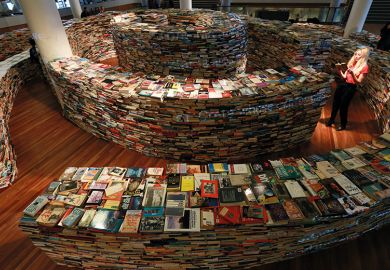This is a catalogue of an exhibition held at the Asia Society in New York in the fall of 1997. Surprisingly, the exhibition did not travel even though the subject has gained widespread familiarity in the West in recent years, due particularly to the endless creation of temporary mandalas with coloured sand by Tibetan monks all over America and Europe and mass Kalachakra initiations, an esoteric Buddhist rite, performed by high ranking Tibetan lamas. Although the mandala was made familiar to the West by the Swiss depth psychologist Carl Gustav Jung over half a century ago, its current popularity must be attributed to the Tibetan diaspora and the consequential spread of Tibetan Buddhism.
The subtitle notwithstanding, one might expect the book to be a comprehensive study of the mandala, for not everyone knows that the word enlightenment has a Buddhist connotation. The exhibition and the catalogue are confined to Buddhist mandalas produced mostly in Tibet with a few examples from Nepal and points further east. Yet mandalas (also referred to as yantra) are just as essential parts of both Hindu and Jain religious praxis, but there is not even a passing reference to them. Those who pick up this book expecting a comprehensive overview of the subject will be disappointed.
This is clearly a case of a misused opportunity, considering how fashionable the concept of the mandala and how intriguing its symbolic meaning is, as is clear from some of the views of at least four writers, including Jung, excerpted in the catalogue. It is a pity that there is none from any contemporary architects, several of whom are known to have been fascinated by the mandala. Charles Correa in India is an eminent example.
The primary focus of this exhibition was to assemble a variety of Tibetan mandalas with a few token objects from a few other cultures, though one cannot help feel that economic considerations played a key role in the selection of objects. Most of the material is well known to scholars of Buddhist art, even though in the catalogue entries the authors have avoided citing any bibliographical references. Otherwise, however, the entries are fairly detailed and informative. The most important Himalayan mandala in the selection is undoubtedly the example from Nepal. Acquired in 1995 by the Metropolitan Museum of New York, it can be dated with the help of carbon-testing to c.1100 which makes it not only the earliest known mandala from the region but it also pushes back the history of Nepali cloth paintings (paubhaa) by two centuries. What is more it is visually delightful.
If one might disagree with the structure and concept of the exhibition, one cannot fault the two essays by Denise Leidy ("Place and process: Mandala imagery in the Buddhist art of Asia) and Robert Thurman ("Mandala: the architecture of Enlightenment"). Leidy's is perhaps the first such attempt to provide an overview of the theme in the context of Asian Buddhist art, while Thurman's introduction to the theory and practice of the mandala is brief and lucid. Those wishing to learn more about the structure and symbology of the Tibetan mandala can move on to Martin Bauen's "The mandala sacred circle in Tibetan Buddhism".
While we admire the mandalas, try to understand their purpose and significance and make them meaningful in our own spiritual lives, we should keep in mind the following sage advice of Lama Khenpo Thubten (as quoted by Bauen in his book).
"The mandala is fundamentally something secret. If you are interested in it in order to acquire reputation, and feel pride in showing what you have worked out to others, you do not have the right attitude. If, however, your work springs from efforts to offer help to other people that is the right attitude of mind, which will contribute to the liberation of yourself and others."
Pratapaditya Pal is fellow for research, Norton Simon Museum, Pasadena, California.
Mandala: The Architecture of Enlightenment
Author - Denise Patry Leidy and Robert A. F. Thurman
ISBN - 0 500 28018 5
Publisher - Thames and Hudson
Price - £14.95
Pages - 176
